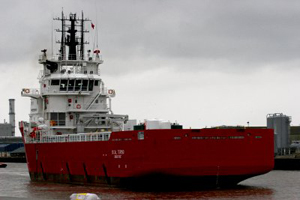A wrinkly material for coating ships’ hulls to prevent barnacles sticking could improve efficiency, cut fuel bills, and reduce clean up costs by millions of dollars across the shipping industry.
Barnacles and other encrustations are the bane of boat owners and the shipping industry. They add weight to a vessel as well as increasing drag and so making the vessel less fuel efficient than it would otherwise be. Tin compounds, such as tributyltin, are very effective but toxic to marine life and have been banned by most governments. So, engineers and scientists have searched for non-toxic ways to prevent barnacle adhesion for years with little success.

Now, John Finlay, Maureen Callow, and James Callow of the University of Birmingham, UK, and Kirill Efimenko and Jan Genzer of the Department of Chemical and Biomolecular Engineering at North Carolina State University (NCSU) have found such an alternative that proved itself effective in 18-month marine trials.
The team reasoned that creating a material with which to coat a hull that has a hierarchy of nesting wrinkles would, like the hierarchical structure of a barnacle-free shark skin, prevent barnacles and the zoospores of the green alga Ulva from firmly latching on to a vessel’s hull. Smooth-skinned sea creatures, such as whales, commonly have encrustations not seen on sharks.
The team produced the wrinkled coating by stretching a rubber sheet and applying an ultra-violet ozone treatment to it. They then released the tension in steps to make the material wrinkle up. They then coated this material with an ultra-thin layer of semifluorinated material, to make it even more non-stick like Teflon, polytetrafluoroethylene. The final material has a hierarchical surface topography with wrinkles of different length scales ranging from tens of nanometres to a fraction of a millimetre.
The individual wrinkle generations are arranged in nested patterns, where each larger wrinkle resides underneath and represents a scaled-up version of the smaller wrinkle, the researchers explain.
The results are very promising, Efimenko explains, We are dealing with a very complex phenomenon. Living organisms are very adaptable to the environment, so we need to find their weakness. And this hierarchical wrinkled topography seems to do the trick.
During ocean tests the materials remained free of barnacles for 18 months of seawater exposure. Flat coatings of the same chemical composition showed barnacle buildup after just one month in seawater. Laboratory experiments indicate that settlement of zoospores of the green alga Ulva and the strength of attachment of sporelings (young plants) depend on the chemical composition of the coating as well as surface topography, the researchers explain.
Further reading
ACS Appl. Mater. Interfac., 2009, 1, 1031-1040
http://dx.doi.org/10.1021/am9000562
Langmuir, 2005, 21, 3044-3053
http://dx.doi.org/10.1021/la048015o
Kirill Efimenko
http://ncsu.edu/nano/faculty/profiles/details.php/11
Jan Genzer
http://ncsu.edu/nano/faculty/profiles/details.php/14
Suggested searches
biofouling
barnacles